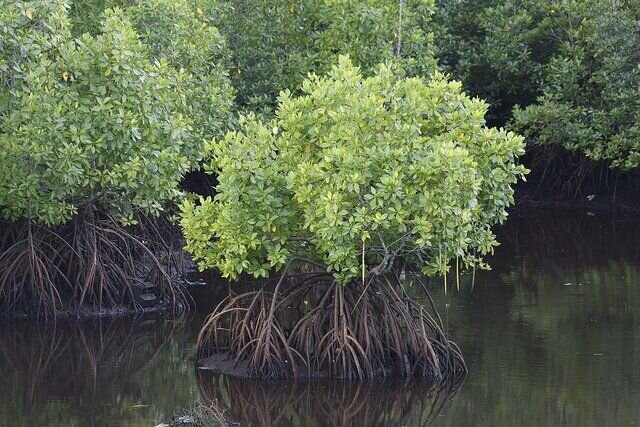Mangrove, the wonder of marine habitats

TEHRAN – The mangrove tree, as a wonder of the marine environment, offers many benefits to various species including birds, fish, crustaceans, and even some terrestrial animals, and stabilizes the soil, as well.
Mangrove forests are rich ecosystems that support the planet and humanity in unique ways by providing conditions for fish growth, storing carbon, and fighting floods.
They are able to store about 6 to 8 tons of carbon per hectare of soil per year.
They contribute to the creation of a complete ecosystem. Above water, mangrove trees provide habitat for birds while amphibians and small fish live on their roots.
Mangroves play a crucial role in preserving the beach soil and protecting it from erosion.
Turtles, crustaceans such as shrimps and crabs, as well as fish take shelter in it to lay their eggs.
In addition, the tree is an important feeding ground for living creatures, providing wood for construction.
Mangrove trees play a vital role in maintaining the ecological balance of the sea coast.
The mangrove tree is a nurturing habitat for every seabird and every aquatic creature in tropical coastal areas. Moreover, animals such as camels and sheep rely on the leaves of the tree as a food source when there is no pasture in the desert.
One of the unique habitats of mangroves is located in Iran.
There are 107 species of mangroves, two of which grow in the country, called Hara and Chandel.
Mangrove forests in Iran mostly consist of the Avicenna marina, known as Hara, named after the 11th-century great Iranian scientist Avicenna or Abu-Ali-Sina.
In Iran, the Hara forest area covers more than 27 thousand hectares.
The forests spread from Nayband Bay in the southwestern Bushehr province to Govater Bay in the southeastern Sistan-Baluchestan province on the coast of the Sea of Oman.
More than 90 percent of these forests, both in terms of quality and quantity, are located in the southern Hormozgan province, such as Khamir Port and Qeshm Island, although there is a part in the Khor Azini site, in Sirik county in Hormozgan, which hosts rhizophora mucronata species, Chandel.
Challenges facing Hara
In 1972, mangrove-covered lands were nationally managed as protected areas.
In 1976, it was accepted and registered as a biosphere reserve.
In 1977, the pristine areas of mangrove forests, flower gardens, and streams in the Strait of Khuran were registered as important wetlands of international value (Ramsar site).
The RAMSAR Convention, an international treaty, was adopted in 1971. Ramsar Wetlands are sites inscribed on the List of Wetlands of International Importance (the "Ramsar List") under the Convention on Wetlands.
Controlling coastal erosion means preventing the destruction of beaches against waves and storms, stabilizing sedimentation, and preventing its movement with a special root system. Protecting coral reefs is an important feature of the mangrove forest in maintaining the biodiversity of the region, and the mangrove forest provides the habitat needs of aquatic animals so that many aquatic species spend their initial stages of growth and reproduction in these forests.
While according to the existing laws, any destruction and pollution of the wetland are prohibited and the forest areas of the country cannot be handed over to natural and legal persons, the Khorbardestan Dayyer wetland and its mangrove forests are facing serious danger due to the construction of roads and the establishment of the shrimp breeding site.
The environmental activists of the region say that such an action and the creation of any structure will prevent fresh water from reaching the mangrove forests and will lead to its depletion. The construction in the tidal range of the mangrove zone should be stopped and we should not cause the migration of birds from the area forever.
MT/MG
